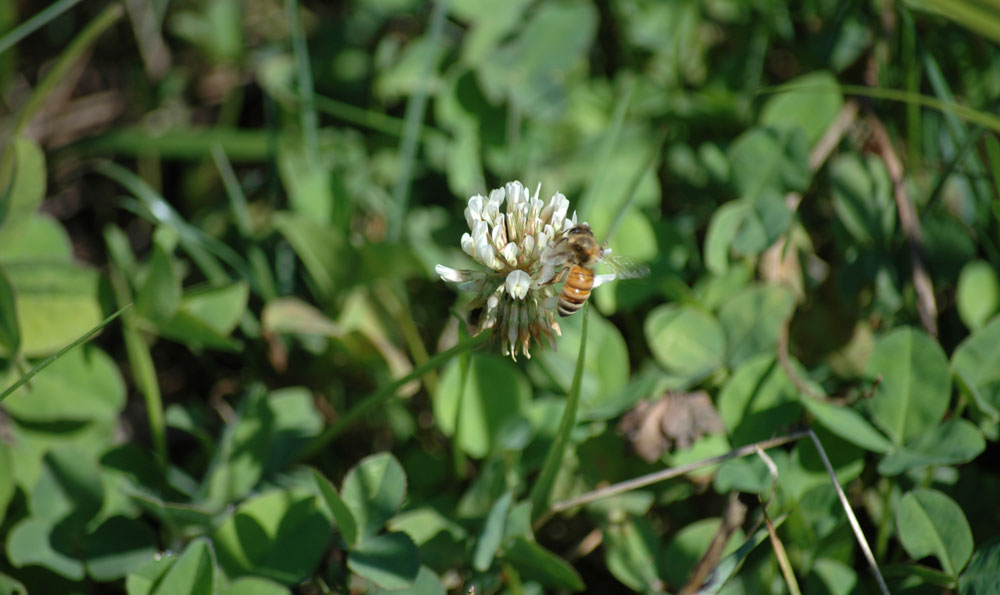Bob Humphrey | Originally published in GameKeepers: Farming for Wildlife Magazine
On my first trip to Texas, I was warned that just about everything there will either stick, sting, stab or bite you. There’s a bit of embellishment in that statement, though it’s not too far from the truth. And though the risks may be a tad less elsewhere, there are potentially dangerous creatures crawling, flying and lurking about potentially everywhere in the outdoors. Fortunately, the risks of encountering them are fairly low, and the potential for serious harm lower still. Just the same, it’s a good idea to be aware of and prepared for what you could encounter. In this article, we’ll cover some insect identification tips and general insect safety tips all outdoorsmen should know.
Wasps, Hornets & Bees

There are countless varieties of wasps and hornets that love to hang out in shooting houses, ground blinds, sheds and outbuildings. Fortunately, about the only ones sportsmen need be concerned with are the vespid wasps, whose ovipositors are adapted into venomous stingers. Hornets and wasps can sting multiple times so you’ll want to dispatch the offending insect by the quickest, most effective means possible. Pain can be quite intense, though physical damage and complications are usually minimal.
Honeybees only get one shot to sting you, sacrificing their lives in the process. Unlike wasps, the bee’s stinger is barbed so it lodges in its victim’s skin. Then the bee pulls away leaving its stinger behind with a small attached sac that continues pumping venom. It also releases a pheromone that incites other bees to attack. If stung, remove the stinger as quickly as possible with a knife blade, credit card or another flat object, being careful not to squeeze the sac.
Bee toxin can be potentially more dangerous because it is a histamine, which causes an allergic reaction. Most victims experience initial pain, followed by swelling, then itching as the sting heals. Some victims may experience a severe allergic reaction and can even go into anaphylactic shock. In mild cases, an antihistamine like Benadryl will counter the reaction. Those highly allergic to bee stings my want to carry an EpiPen with them at all times.
Though uncommon, Africanized bees, or so-called “killer bees” can be found primarily in the southwest. The greatest danger is from their aggressive nature. They’ll attack in large swarms and follow their victims much farther from the hive than European bees. If attacked, get as far away as fast as you can, or seek shelter in an enclosure.
Though far less common and largely docile, bumblebees also sting. The result is typically pain followed by swelling, redness and itching, which usually lasts only a couple of hours. In rare cases, and only after repeated stings, there may be an allergic reaction.
Obviously, avoidance is the first and best step, though we still sometimes get stung. You may not find it in the medical journals, but I’ve found applying diluted ammonia to a sting will reduce pain and swelling. Other folk remedies include vinegar or a solution of one part meat tenderizer to four parts water. In the case of a severe reaction, seek medical treatment.
Spiders and Scorpions

You’ll find spiders most anywhere and everywhere, but some of the worst offenders like to hang out in places you nestle into when turkey hunting like wood piles and fallen trees. You’ll also find them in dark, neglected corners of old buildings, ground blinds and shooting houses. Most spiders are relatively harmless. There’s a dozen or so that are venomous, and at least three you should be aware of.
The black widow can inflict a bite that’s quite painful and in rare cases potentially fatal. They produce a potent neurotoxic protein. The severity of the reaction differs with age and physical condition of the victim, with children and the elderly being particularly susceptible. Pain may be followed by severe muscle cramps, abdominal pain, weakness, and in extreme cases, nausea, vomiting, fainting, dizziness, chest pain, and respiratory difficulty.
Though much scarier looking, the tarantula is less dangerous. Their size makes them hard to miss and they often signal their intent prior to attacking by rearing up into a threat posture, extending their fangs and even making a loud hissing noise. The result of a bite is similar to that of a wasp sting.
Last, but by no means least, is the brown recluse or fiddle-back spider. At less than an inch long, this nondescript arachnid packs quite a wallop. Initially, its bite may feel like a pinprick or even go unnoticed, and most heal without scarring. However, some bites can result in intense pain and systemic reactions such as itching, fever, chills, nausea, vomiting or even shock. In severe cases, the bite causes extensive tissue necrosis (death) and a sunken ulcerating sore that may take weeks or even months to heal.
Though they seem far more sinister, at least to me, scorpions are about as common as spiders and as dangerous as wasps. Their stings usually result in pain with minimal swelling and tenderness. One exception is the bark scorpion, which occurs in Arizona, New Mexico and the California side of the Colorado River. It has a much more toxic, painful sting that can result in more serious symptoms, especially in children.
Again, the best solution is avoidance. Stay away from preferred spider and scorpion habitat as much as you can. Check before you sit down and keep your buildings and blinds clean and tidy. Also remember that scorpions like dark, warm places. In scorpion country, it’s standard practice to check your boots every morning before putting them on. Turn them over and pound on them. Don’t stick your hand in!
In all cases, if bitten, try to collect the perpetrator (even a mangled specimen) for positive identification. Remain calm and seek help. Apply an ice pack directly to the bite area to relieve swelling and pain. Consult a physician and if severe symptoms occur seek medical attention immediately.
Ticks and Chiggers

Far more outdoorsmen encounter the spider’s distant eight-legged cousins, ticks and chiggers. About all you have to do is go outside at the right time of year. Still, there’s much you can do to reduce exposure, starting with insect identification and avoidance. You should also add tick protective clothing, like Gamehide ElimiTick, to your mental book of insect safety tips.
Shortly after hatching, tiny chigger larvae climb up onto vegetation where they lie in wait for a passing host. Once aboard, they insert their mouthparts in a skin pore or hair follicle and inject a salivary secretion containing powerful, digestive enzymes. They often “attack” en masse leaving the victim with small, reddish welts accompanied by intense itching. There are all sorts of remedies for temporary relief ranging from the somewhat reliable (ointments of benzocaine, hydrocortisone, calamine lotion and After Bite) to the somewhat outlandish (Vaseline, cold cream, baby oil, fingernail polish and Listerine).
In general, ticks aren’t all that harmful. They attach to a host, then engorge themselves with the host’s blood before dropping off. The aftereffects are usually about the same as a mosquito bite. However, ticks can transmit a whole host of diseases including Rocky Mountain spotted fever, babesiosis, human erlichiosis and Lyme disease.
Recognizing whether you’ve been infected can be very difficult and diagnosis is best left to a physician. Things to look for include a rash — especially the so-called bulls-eye rash that can signify Lyme disease — signs of infection such as redness, warmth swelling and pain, or symptoms like fever, headache, fatigue, chills, stiff neck muscles or joint aches. Regardless, when in doubt, see a doctor; and save the tick if you can.
According to the experts, most of the aforementioned diseases are not transmitted if you remove the tick within 24 hours of attachment. Check yourself every day after leaving the field.
Once again, the best remedy is avoidance. One way is to wear a tight-fitting base layer. Another is to apply permethrin - a chemical sold under several different trade names - to your clothing. Spray it on. Let your clothes dry and the permethrin will act as an effective insecticide for several weeks. Standard repellents like DEET also work but have much shorter periods of effectiveness, and require frequent re-application.
Mosquitoes & Black Flies
This group is the most abundant. Fortunately, they’re more of an annoyance than anything else.

Mosquitoes suck…. more precisely, the females suck blood from their victims. Their bite amounts to little more than an itchy welt. However, they can transmit diseases such as West Nile virus and eastern equine encephalitis to humans, both of which can be potentially fatal.
Black flies (also called buffalo gnats or white socks) are a bit less delicate. They use tiny mouthparts to grasp and spread your skin, then slice through it with their jaws. The result is also an itchy welt. And because they attack in swarms, often many such welts. The black fly can transmit a parasitic nematode that causes river blindness. However, about the closest it gets is southern Mexico.
Though the most abundant, this group is also among the easiest to deal with. In most cases only exposed skin is vulnerable, so wearing a head net and gloves is one solution. Insect repellent is another. However, most repellents have an odor that deer may detect.
Another, more effective option is something called a Thermacell. It’s a small portable device consisting of a tiny heating element powered by a replaceable butane cartridge and a pad saturated with a synthetic copy of a naturally occurring insecticide. When activated, the device will maintain a 200 square foot mosquito-free zone.
Fear Not
The outdoors is filled with creepy, crawly creatures that range from mildly annoying to potentially fatal. But that shouldn’t prevent you from venturing afield. Encounters with the most dangerous are rare, and remedies exist for most. And always remember that an ounce of prevention is worth a pound of cure. Logging away these insect safety tips will help keep you safe out in the field.



























